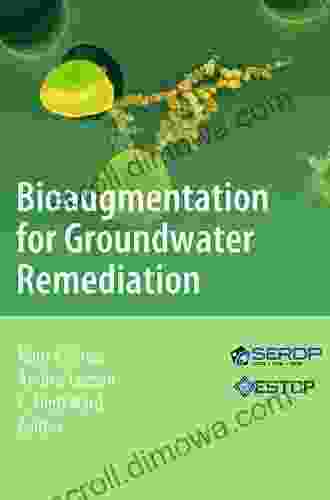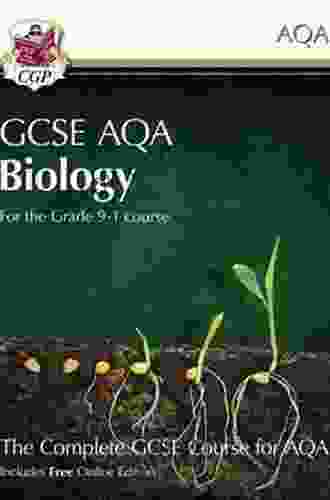Bioaugmentation For Groundwater Remediation: A Comprehensive Guide

Groundwater is a vital resource, providing drinking water to millions of people worldwide. However, groundwater can become contaminated by various pollutants, such as industrial solvents, petroleum hydrocarbons, and chlorinated compounds, posing significant health and environmental risks.
Bioaugmentation, a promising environmental remediation technique, offers a sustainable solution for groundwater cleanup. This innovative approach involves introducing carefully selected microorganisms into contaminated groundwater, harnessing their natural ability to degrade and remove pollutants.
4.5 out of 5
| Language | : | English |
| File size | : | 11152 KB |
| Text-to-Speech | : | Enabled |
| Enhanced typesetting | : | Enabled |
| Print length | : | 718 pages |
| Screen Reader | : | Supported |
Principles of Bioaugmentation
Bioaugmentation is based on the principle that certain microorganisms possess the metabolic capabilities to transform and degrade specific pollutants. These microorganisms are typically bacteria or fungi that have evolved to utilize these compounds as energy sources.
When introduced into contaminated groundwater, these microorganisms can effectively break down the pollutants into less harmful substances, such as carbon dioxide, water, and biomass. The process involves various enzymatic reactions that convert the pollutants into intermediates and eventually into harmless end products.
Applications of Bioaugmentation
Bioaugmentation has proven effective in remediating a wide range of groundwater contaminants, including:
- Petroleum hydrocarbons (e.g., benzene, toluene, ethylbenzene, xylenes)
- Chlorinated solvents (e.g., trichloroethylene, tetrachloroethylene)
- Industrial solvents (e.g., acetone, methanol, ethanol)
- Pesticides (e.g., DDT, lindane)
- Metals (e.g., chromium, lead, mercury)
The applicability of bioaugmentation depends on several factors, including the nature of the contaminants, groundwater conditions, and the presence of indigenous microorganisms capable of degrading the target pollutants.
Benefits of Bioaugmentation
Bioaugmentation offers numerous advantages over traditional groundwater remediation methods:
- Sustainability: Bioaugmentation utilizes naturally occurring microorganisms, making it an environmentally friendly approach with minimal long-term impacts.
- Cost-effectiveness: Compared to other remediation techniques, bioaugmentation can be more cost-effective, particularly for large-scale cleanup projects.
- In situ application: Bioaugmentation can be implemented directly at the contaminated site, eliminating the need for excavation or off-site treatment.
- Enhanced biodegradation: Bioaugmentation introduces specialized microorganisms that can enhance the rate and efficiency of pollutant degradation.
- Long-term effectiveness: Once established, the introduced microorganisms can continue to degrade pollutants for extended periods, providing long-term groundwater protection.
Optimizing Bioaugmentation Strategies
To maximize the success of bioaugmentation projects, careful planning and optimization are essential. Key considerations include:
- Microbial selection: Choosing the right microorganisms for the specific contaminants and groundwater conditions is crucial for effective degradation.
- Delivery methods: Various methods can be used to introduce microorganisms into groundwater, such as injection, infiltration, or bioaugmentation wells.
- Nutrient amendment: Providing essential nutrients, such as nitrogen and phosphorus, can support the growth and activity of the introduced microorganisms.
- Oxygen management: Oxygen availability can influence microbial degradation processes. Monitoring and adjusting oxygen levels may be necessary.
- Monitoring and evaluation: Regular monitoring is essential to assess bioaugmentation progress, evaluate contaminant reduction, and make necessary adjustments.
Case Studies and Success Stories
Numerous successful bioaugmentation projects have been implemented worldwide, demonstrating the effectiveness of this approach. Case studies have shown significant reductions in groundwater contamination levels, improved water quality, and restored ecosystem health.
One notable example is the remediation of a groundwater plume contaminated with trichloroethylene (TCE) at a former industrial site. Bioaugmentation, combined with other remediation techniques, achieved a 99% reduction in TCE concentrations over a period of several years.
Bioaugmentation is a transformative groundwater remediation technology that harnesses the power of nature to clean up contaminated aquifers. By introducing carefully selected microorganisms, this approach provides a sustainable, cost-effective, and long-term solution for groundwater protection.
As research and development continue, bioaugmentation techniques are不断改进ing, offering even greater potential for the remediation of groundwater contamination. With its proven effectiveness and numerous benefits, bioaugmentation is poised to play a pivotal role in the future of groundwater management and environmental stewardship.
For further in-depth exploration of bioaugmentation for groundwater remediation, we highly recommend the book "Bioaugmentation for Groundwater Remediation: SERDP-ESTCP Environmental." This comprehensive guide provides detailed insights into the principles, applications, and optimization strategies of bioaugmentation, making it an invaluable resource for environmental professionals and researchers.
4.5 out of 5
| Language | : | English |
| File size | : | 11152 KB |
| Text-to-Speech | : | Enabled |
| Enhanced typesetting | : | Enabled |
| Print length | : | 718 pages |
| Screen Reader | : | Supported |
Do you want to contribute by writing guest posts on this blog?
Please contact us and send us a resume of previous articles that you have written.
 Book
Book Novel
Novel Page
Page Chapter
Chapter Text
Text Story
Story Genre
Genre Reader
Reader Library
Library Paperback
Paperback E-book
E-book Magazine
Magazine Newspaper
Newspaper Paragraph
Paragraph Sentence
Sentence Bookmark
Bookmark Shelf
Shelf Glossary
Glossary Bibliography
Bibliography Foreword
Foreword Preface
Preface Synopsis
Synopsis Annotation
Annotation Footnote
Footnote Manuscript
Manuscript Scroll
Scroll Codex
Codex Tome
Tome Bestseller
Bestseller Classics
Classics Library card
Library card Narrative
Narrative Biography
Biography Autobiography
Autobiography Memoir
Memoir Reference
Reference Encyclopedia
Encyclopedia Hope Larson
Hope Larson William J Bottega
William J Bottega Steve Gordon
Steve Gordon Andrew Jack
Andrew Jack Laura Peyton Roberts
Laura Peyton Roberts Seema Rahmani
Seema Rahmani Evan Tate
Evan Tate Catherine L Aman
Catherine L Aman Cathy Mayes
Cathy Mayes Catherine Chant
Catherine Chant Charles Barfi
Charles Barfi Chad Gervich
Chad Gervich Thomas Paul Tarshis
Thomas Paul Tarshis George Michell
George Michell Denise Malan
Denise Malan Cecil Kuhne
Cecil Kuhne Cathal Coyle
Cathal Coyle D R F West
D R F West Toni L Coleman Carter
Toni L Coleman Carter Robert Harker
Robert Harker
Light bulbAdvertise smarter! Our strategic ad space ensures maximum exposure. Reserve your spot today!
 Adrian WardFollow ·4.1k
Adrian WardFollow ·4.1k John KeatsFollow ·4.2k
John KeatsFollow ·4.2k Thomas PowellFollow ·3.3k
Thomas PowellFollow ·3.3k Steve CarterFollow ·13.7k
Steve CarterFollow ·13.7k Jeff FosterFollow ·15.7k
Jeff FosterFollow ·15.7k Easton PowellFollow ·16k
Easton PowellFollow ·16k Milton BellFollow ·9.8k
Milton BellFollow ·9.8k Robert HeinleinFollow ·16k
Robert HeinleinFollow ·16k

 Lawrence Bell
Lawrence BellThe Life and Legacy of Voltaire: A Monumental Exploration...
Enlightenment...

 F. Scott Fitzgerald
F. Scott FitzgeraldThe Captain Quest: A Captivating Saga of Adventure,...
Prepare to embark on an...

 Gabriel Mistral
Gabriel MistralUnveiling the Secrets of Navigation and Map Reading: A...
: A World of...

 Steven Hayes
Steven HayesThe Lives and Legacies of John and John Quincy Adams: A...
John Adams and...
4.5 out of 5
| Language | : | English |
| File size | : | 11152 KB |
| Text-to-Speech | : | Enabled |
| Enhanced typesetting | : | Enabled |
| Print length | : | 718 pages |
| Screen Reader | : | Supported |















